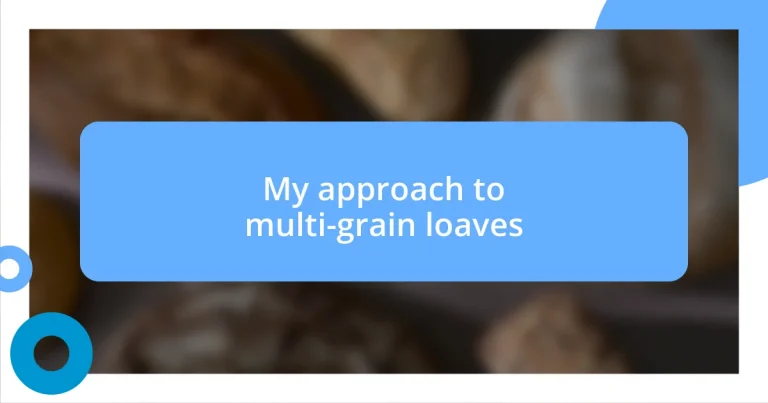Key takeaways:
- Multi-grain loaves combine various grains and seeds, enhancing flavor, texture, and nutritional value, with benefits like better digestion and sustained energy.
- Choosing grains such as whole wheat, oats, barley, spelt, and quinoa allows for a balance of taste and health benefits, with unique flavors emerging from different combinations.
- Key baking techniques include controlling temperature, creating steam for a perfect crust, and allowing the loaf to cool before slicing to enhance flavor and texture.
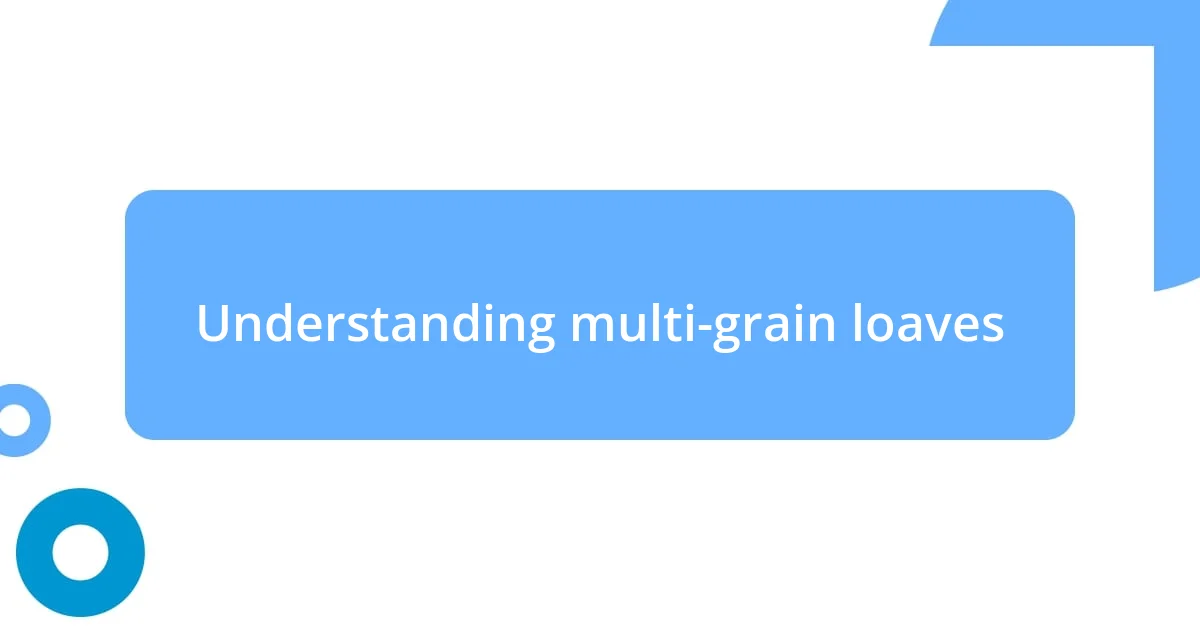
Understanding multi-grain loaves
Multi-grain loaves are fascinating because they incorporate various grains and seeds, creating a unique blend of flavors and textures. I remember the first time I bit into a fresh slice, with that delightful nuttiness and a hint of sweetness from the seeds; it was an eye-opening experience that challenged my previous notions of what bread could be. Have you ever felt that excitement when discovering a new favorite food?
In my experience, selecting the right grains is crucial for achieving the perfect balance of nutrition and taste in multi-grain loaves. For instance, using whole wheat flour as a base adds fiber and nutrients, while adding flaxseeds introduces omega-3 fatty acids, which many people overlook. When I make my own loaves at home, I often experiment with different combinations, and it’s exciting to see how each tweak impacts the final product.
The artistry behind multi-grain bread goes beyond just the ingredients; it’s about the process, too. I’ve found that allowing the dough to rest and develop flavor enhances the overall taste, creating a loaf that’s not just good for you but also incredibly satisfying. Isn’t it rewarding to know that the bread you’re enjoying is both delicious and nourishing?
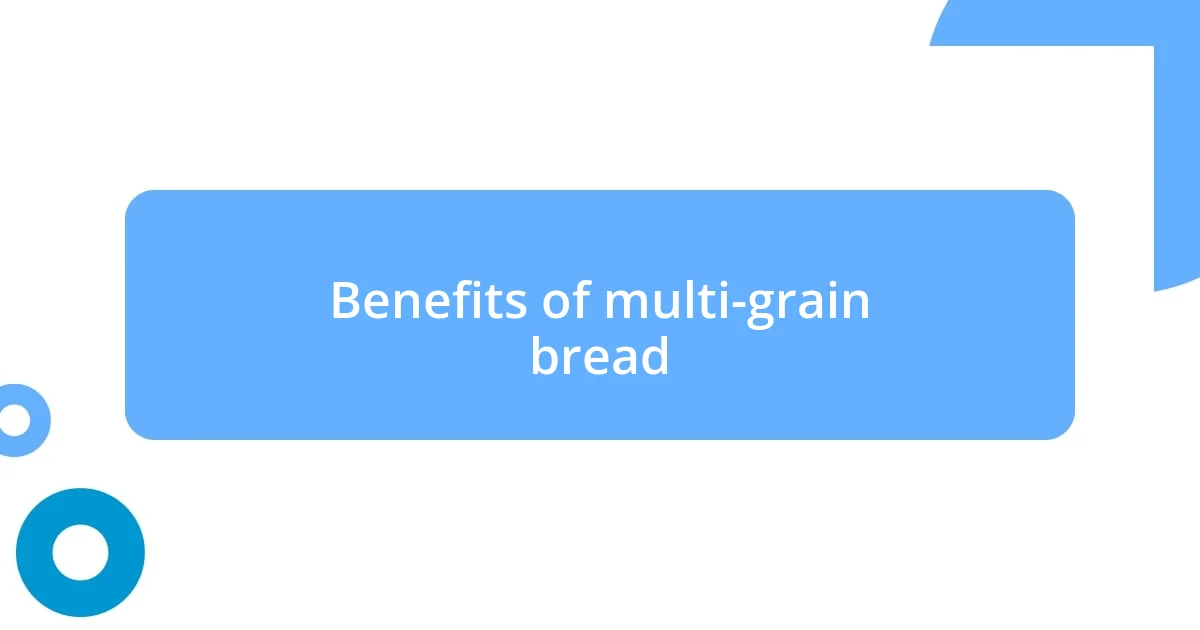
Benefits of multi-grain bread
Multi-grain bread offers a wealth of nutritional benefits that can’t be overlooked. The blend of grains, such as barley, oats, and quinoa, enriches the bread with essential vitamins and minerals. I remember the first time I swapped my usual white bread for a slice of multi-grain; it felt like I was taking a step towards a healthier lifestyle. Did you know that the variety of grains supports better digestive health due to their diverse fiber content?
Another standout benefit is the sustained energy release from multi-grain bread. Unlike white bread, which can lead to a quick blood sugar spike, the complex carbohydrates in multi-grain varieties provide longer-lasting energy. I’ve personally noticed that after enjoying a multi-grain sandwich for lunch, I stay focused and energized well into the afternoon. Isn’t it great to fuel your body with foods that keep you going all day?
Finally, multi-grain bread’s flavor profile is a treat in itself. The combinations of grains and seeds create a delightful texture and taste experience. I still recall the surprise of tasting a slice adorned with sunflower seeds and sesame; it was a satisfying crunch that elevated my typical breakfast. Have you ever tried pairing multi-grain bread with avocado and a sprinkle of sea salt? It’s a match made in heaven!
| Benefit | Description |
|---|---|
| Nutritional Value | Rich in vitamins, minerals, and fiber due to multiple grain sources. |
| Energy Levels | Provides sustained energy release, preventing blood sugar spikes. |
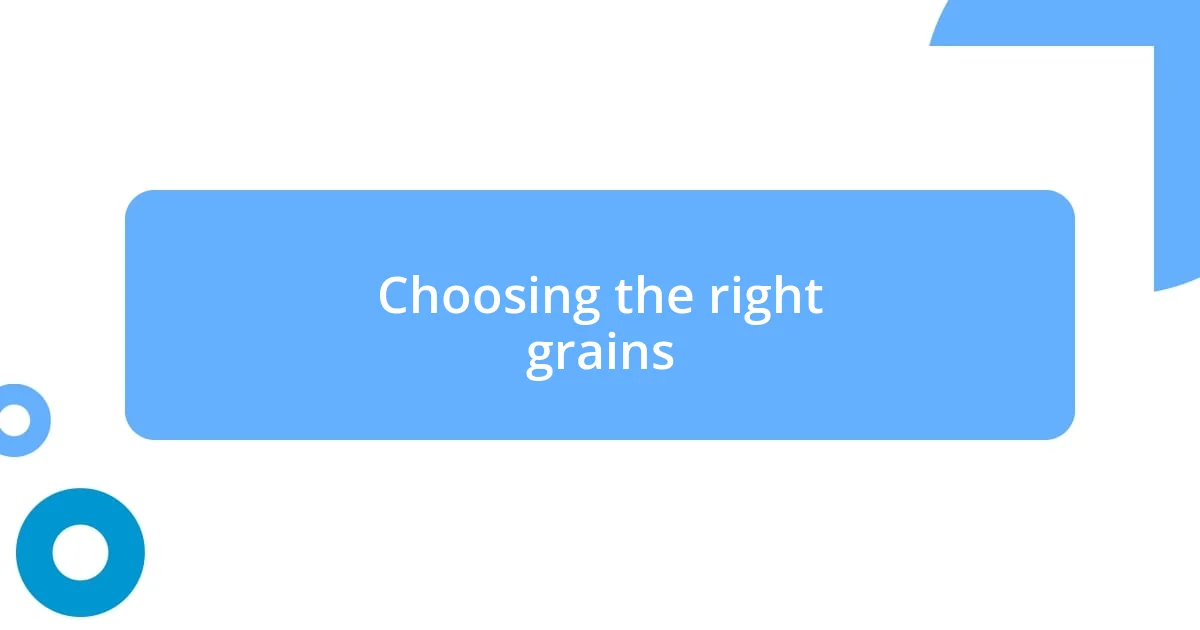
Choosing the right grains
When it comes to choosing the right grains for my multi-grain loaves, I like to think about the flavors and health benefits each grain offers. For instance, I often lean towards oats and barley for their chewy textures, which make every bite interesting. An unforgettable moment for me was when I baked a loaf packed with spelt; the nutty notes combined beautifully with my homemade herb butter. I’ll never forget how delighted my friends were as they tasted the loaf and couldn’t believe the depth of flavor.
Here’s a breakdown of some great grains to consider:
- Whole Wheat: High in fiber and nutrients, it forms a solid nutritional base.
- Oats: Helps in creating a soft texture while adding a subtle sweetness.
- Barley: Adds a chewy bite and is rich in soluble fiber, which is great for heart health.
- Spelt: A unique nutty flavor and good source of protein.
- Quinoa: Gluten-free, packed with amino acids, and gives a delightful crunch.
With every loaf I bake, I consciously choose grains that not only boost nutrition but also awaken my taste buds and those of my family and friends. It’s an exploration through flavors, just like trying out a new recipe and discovering a new passion!

Preparing your multi-grain dough
When I prepare my multi-grain dough, I start with warm water and yeast, mixing them together until the yeast blooms. There’s something magical about watching it come alive, bubbling and frothing like a mini science experiment. Have you ever noticed how the smell of yeast can instantly transport you to a cozy bakery? That aroma fills me with anticipation for what’s to come.
Next, I incorporate the grains. I love using a blend of rolled oats, seeds, and whole wheat flour because it provides both texture and taste. I remember an instance when I decided to add flaxseeds to my dough; the nutty flavor paired perfectly with the other grains, and the added crunch made my loaf feel so satisfying. I can’t help but wonder, have you ever tried mixing different grains to create your unique blend?
I always take my time to knead the dough gently. There’s an art to it, a rhythm that feels almost meditative, as I fold and stretch it. The dough needs to feel elastic – that’s when I know it’s ready. It’s like nurturing something special, watching it transform from a sticky mixture into a smooth ball of potential. When it rises, I feel a sense of pride; it’s not just bread, it’s a small piece of my heart.

Techniques for perfect baking
When it comes to baking multi-grain loaves, I’ve found that temperature control is crucial. I like to keep my oven preheated to a consistent setting, around 375°F (190°C), as this ensures an even bake. There was a time I got distracted, and my oven’s temperature dipped slightly; let me tell you, the difference was noticeable. The crust just didn’t have that golden crunch I crave. Have you ever had a loaf that didn’t turn out quite right? It’s all in those small details!
Another technique I swear by is steam during baking. I usually place a pan of hot water on the bottom rack or mist my bread with water right before closing the oven door. This little trick creates that perfect crust and gives my loaves a beautiful rise. The first time I did this, I was grinning ear to ear as I pulled out a loaf that looked like it belonged in a bakery. It’s amazing how a simple addition can elevate the whole baking experience, wouldn’t you agree?
Lastly, I pay close attention to the resting phase after baking. Patience is key! Allowing the loaf to cool completely before slicing helps it develop its flavors and maintain that beautifully soft texture inside. I once sliced into a warm loaf on a whim, and the result was a crumbly mess! Trust me, the wait is worth it when you get to enjoy that perfect slice later. Have you learned the hard way about the joys of waiting, too? It’s moments like these that truly make baking an adventure.

Flavor enhancements for multi-grain loaves
Flavor enhancements can truly transform a multi-grain loaf into a culinary delight. I often experiment with ingredients like honey or maple syrup, adding just the right amount of sweetness to balance the nuttiness of the grains. Once, after using honey for a batch, the loaf emerged with a soft, aromatic crust that left my kitchen smelling like a cozy café. Doesn’t a hint of natural sweetness make you curious about the next slice?
Herbs and spices can also create an exciting depth of flavor. I’ve had great success sprinkling in a bit of rosemary or even using a dash of cinnamon for a comforting twist. There was a day when I tossed in some freshly chopped basil – the result was nothing short of a flavor explosion! Have you ever discovered an unexpected herb that elevated a dish? I can still picture that delicious bread on my table, garnished with a drizzle of olive oil, a perfect pairing.
Lastly, don’t underestimate the power of seeds. I enjoy using sesame seeds or sunflower seeds, both for their crunch and their flavor. I remember one time, I topped my loaf with a mix of seeds before baking; it added not just texture but also a delightful nutty flavor that kept friends coming back for more. Have you ever noticed how a simple addition can spark joy in a familiar recipe? These enhancements make each loaf unique and memorable, inviting a little adventure into every bite.
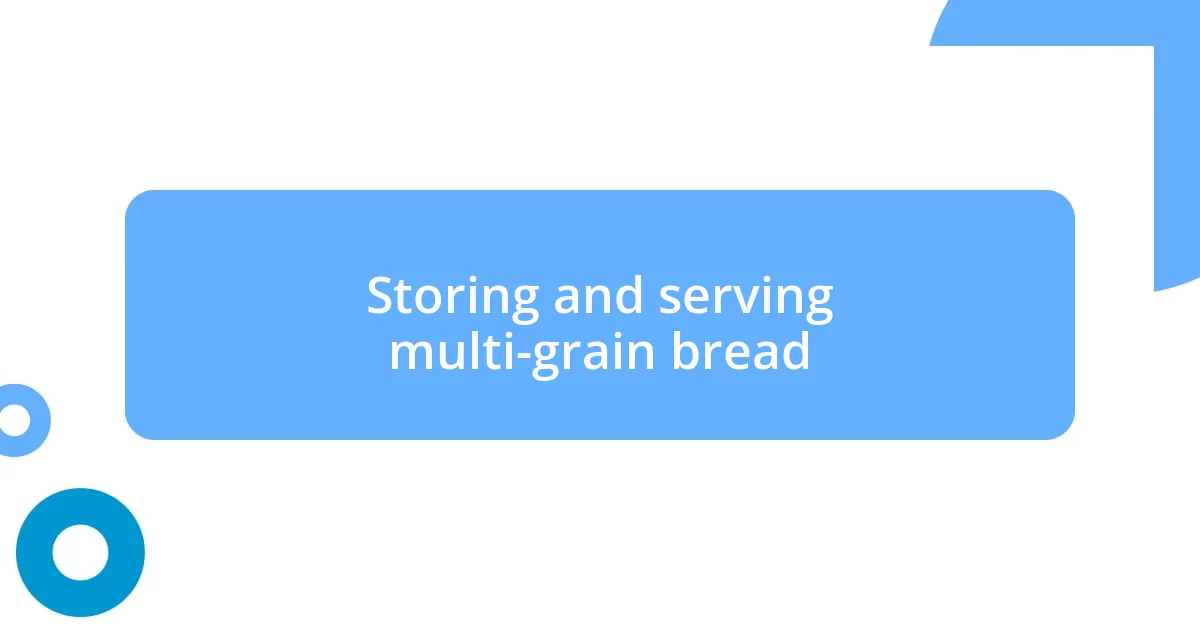
Storing and serving multi-grain bread
When it comes to storing multi-grain bread, I’ve learned that keeping it fresh requires a bit of know-how. I prefer to wrap my loaves in a clean kitchen towel and place them in a paper bag rather than plastic. This method allows the bread to breathe while helping maintain that crispy crust I adore. Have you ever faced the dilemma of a loaf turning soggy? It’s such a disappointment, but using the right storage can make all the difference.
If you know you won’t finish the loaf in a few days, I recommend freezing it. I typically slice the bread before freezing, so I can grab just what I need later. The first time I defrosted a slice, I was delighted to find it tasted almost as fresh as when it came out of the oven. It’s like a little taste of homemade bliss, wouldn’t you agree? Just remember to wrap it tightly in plastic wrap or a freezer bag to prevent any freezer burns.
Serving multi-grain bread can be a joyous experience, too. I love toasting slices for breakfast, then slathering them with a bit of avocado or nut butter. There’s something about that combination that elevates my morning routine. Have you ever considered how the right toppings can completely transform a humble slice? It’s fascinating how a simple piece of bread can hold so much potential for flavor and satisfaction when paired thoughtfully.












